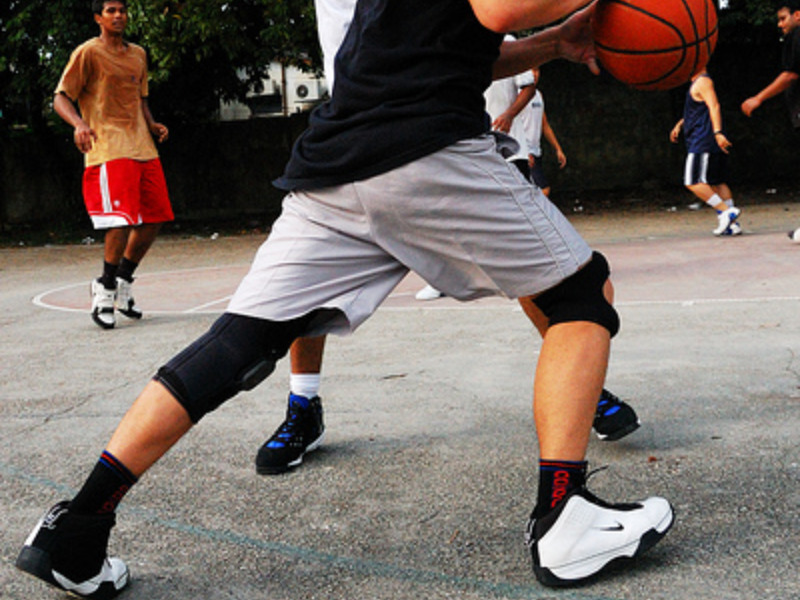Patellofemoral pain in adolescence: much more prevalent than appreciated
| Patellofemoral pain is common among adolescents. |
Musculoskeletal conditions are not unique to the adult population. From the age of 5–9 years to the age of 10–14 years there is an almost fourfold increase in the years lived with disability as a result of musculoskeletal conditions.

Jumper’s knee in young athletes. no focus / flickr
Dr M S Rathleff, Fyrkildevej 7, 1, Aalborg East 9220, Denmark. British Journal of Sports Medicine May 2016
In Danish primary care, we see an eightfold increase in the number of contacts to general practice because of knee symptoms between 5–9 and 10–19 years. This makes knee pain one of the most common sites of pain in adolescents. Our research shows that 6–7% of the adolescent population is affected (in varying severities) by patellofemoral pain (PFP). This makes PFP one of the most common knee conditions among adolescents.
Depending on how you define adolescence and adulthood, more than 95% of all research on PFP is carried out on adults. This does not match the high prevalence among adolescents. It is appreciated that children are not small adults—adolescents appear to need their own attention too.
| Who are the adolescents with PFP? |
PFP is highly prevalent in people who do a lot of sports. In adolescent female basketball players, it may be as high as 16%. In our population-based study, two-thirds of the adolescents with PFP were highly active and engaged in sport, on average five times per week (even with knee pain!) But there was also a subgroup (∼1/3) who did not do any sports at all.
This is important, and challenges the common notion that PFP is always a load-dependent condition associated with sports. However, the high prevalence in sports population suggests that highly repetitive and/or excessive and specific loading contributes to the pathogenesis of PFP in adolescents.
| Is adolescent PFP self-limiting? |
A common notion is that knee pain and PFP is a natural part of adolescence and is self-limiting. We recently made a follow-up of 153 adolescents with PFP for 2 years and 65% of them still had knee pain after a 2-year follow-up and a quarter of them reported they had daily knee pain.
Importantly, a large proportion of the adolescents with PFP stopped or reduced their sports participation during the 2 years—PFP can impair the overall health. These findings extend previous retrospective long-term follow-up studies on adolescents with PFP and highlight the high persistence rates. We need to discard the common misconception that PFP is ‘self-limiting’ and focus on how best to manage it.
| Exercise therapy may not be for everyone |
Exercise therapy is one of the mainstays of treating PFP. In an adolescent population, adding exercise therapy to patient education improved the recovery rates in both short term (3 months) and long term (24 months). However not all adolescents responded favourably to exercise therapy and the overall recovery rates was lower than what has been observed among adults.
This suggests that exercise therapy is effective for some adolescents, but not all. So the question is how we can improve the effects of exercise therapy among adolescents to improve its outcomes? The key may be in an increased focus on managing training loads for the group of highly active adolescents with PFP. Importantly, frequent sports participation is a risk factor for persistent knee pain among young adolescents aged 12–15 years and failure to modify sports participation could hinder recovery. This raises the question, does our current evidence-based approach have too much focus on exercise therapy and too little focus on training load management?
| Adherence to exercises is a challenge |
In our recent randomised trial on adolescent PFP, the majority of adolescents adhered poorly to the exercise programme. Those who did their home exercises three times per week or more were four times more likely to be recovered after 12 months compared with those with poor adherence (<1 exercise session per week).
Adherence is vital, and requires greater understanding of the barriers and facilitators for good adherence. It is essential that the adolescents and the parents are educated about the importance of adherence and understand why the exercises are important.
| Tailoring management and future directions |
Training load management and exercise therapy is likely to be a part of successful treatment of adolescents with PFP; however, there are several areas that need further exploration. These include areas such as psychology, pain mechanisms and social support, which may all be specific to adolescents.
The discussions at the Fourth International Patellofemoral Research Retreat in September 2015 highlighted these issues. The consensus was that we need to consider the entire spectrum of the patellofemoral continuum, from PFP in adolescence to patellofemoral osteoarthritis, tailor treatment and avoid assuming that one size fits all.
Patellofemoral pain during adolescence: much more prevalent than appreciated, M S Rathleff. Br J Sports Med 2016;50:831-832 doi:10.1136/bjsports-2016-096328
